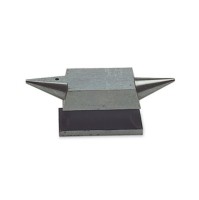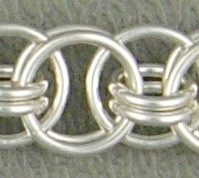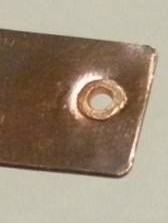- NEW DVD Series – Stone Setting with Bezels
- Tube Set Charm by Kim St. Jean
- Prong Basket Pendant by Kim St. Jean
- NEW DVD Series – Stone Setting with Cold Connections
- New DVD Series – Stone Setting with Wire
- NEW DVD Series: Introduction to Stone Setting by Kim St. Jean
- Featured Tool: Bracelet Bending Plier
- NEW Dvd by Eva Sherman
- Fun, Fast Fold Forming DVD Series
- Double Band Ear Cuff from Alex Simkin
Daily Wire Tip: Drilling Holes in Gemstones
Daily Wire Jewelry Making Tip
Question:
My husband is interested in drilling holes in gemstone beads or slabs that don’t have one yet. What’s the best way to go about it? What tools will we need?
Answer:
Each lapidary has their favorite tools and procedures for drilling holes in rock material; the following is how we drill holes in slabs in my studio.
We took a round cake pan and cut a piece of wood the same size. We put the wood in the bottom of the pan and filled it about 1/3 of the way with water. (It is imperative that rock be drilled in water to flush out the rock ‘mud’ as it grinds away and to keep both the material and drill bit cool.) This pan is then placed under a hand-operated drill press fitted with a diamond bit. (Choose a sintered bit that has diamond impregnated throughout the bit whereas a plated bit just has diamond around the outside edges and will wear out very quickly.) Using a constant up and down motion, the drill is continuously and evenly pressed against and into the rock, until a hole goes through it. Depending on both the hardness of the material being drilled and the desired depth of the hole, be prepared to go through several diamond bits before the hole is finished. (We have our dentist save his ‘used’ diamond drill bits for us as they usually have lots of use left when he is ready to discard them.)
Answer contributed by Dale “Cougar” Armstrong
Have a question? Submit your question here!























Jessie Adams
November 24, 2009 at 1:28 am
I remember when we did some sodalite beads and drilled them out for beads. It was really time consuming and was really satisfactory in the end when I was able to tell customers that these were beads we had made, only problem was that when we calculated out cost they came out to about a dollar per bead and that was twenty years ago.
Doing it for your own satisfaction is great, but if you intend to do it commercially, make sure you have a venue that will be able to meet your price point. A lot of us get into this business for love of the art and materials; reality though states we need to make a buck.
Word of Warning: make sure you wear a dust mask and safety glasses when you are drilling, if your material shatters you definitely need that protection. Equally important to know when working rock like malachite, turquoise, azurite and other copper minerals, is that their dusts are toxic if inhaled. (All it takes is a moment).
Be safe and have fun
J
Dee Tudor
July 3, 2012 at 11:01 am
Thank you for the reminder of toxic dust, that’s good to know. Think I will just go with predrilled!
mary
November 24, 2009 at 9:00 am
Now that’s a great tip to pass on to the husband so he can drill some things for me. Thanks Dale!
dalecgr
November 24, 2009 at 1:11 pm
For Melanie, most of the folks who come to me with this particular challenge are using half-round wire to make their wraps with. Try changing to square, half-hard as a bracelet is in a high traffic area and needs the strength of the square, half-hard. Rarely do I or my students use a half-round wire to make bracelet wraps and when we do, it’s a 16 or 18 gauge, with half-hard temper.
Dale/Cgr
Pingback: Creating Larger Gemstone Holes
Chris Adam
July 3, 2012 at 5:35 am
When drilling stone its a good idea to drill from both sides to prevent “chipping out” I like to mount a little piece of wire as a peg to line up the stone for the other side, and flip the stone over after drilling part way from one side.
Jenny Smith
June 27, 2013 at 12:27 pm
How do stabilize the stone while drilling it? Dale, I have thoroughly enjoyed your comments and tips in the past and of course your books.